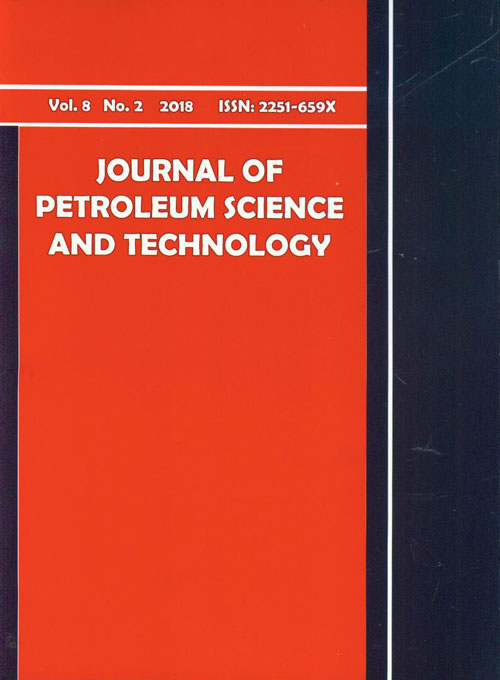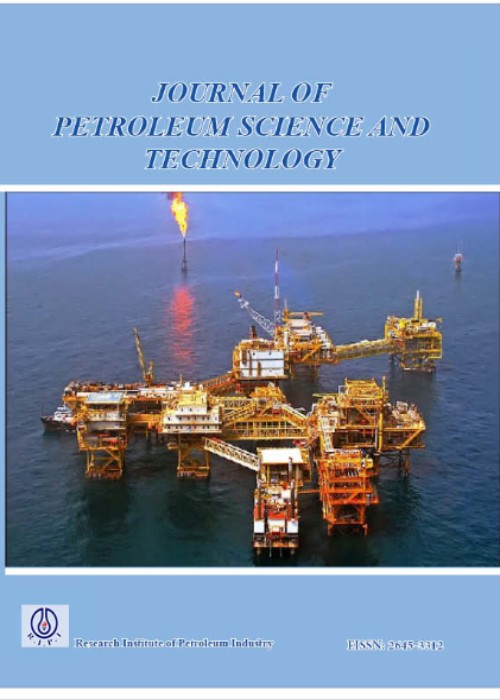فهرست مطالب

Journal of Petroleum Science and Technology
Volume:8 Issue: 2, Spring 2018
- تاریخ انتشار: 1397/03/05
- تعداد عناوین: 6
-
-
Pages 3-13To fully utilize the siliceous whiskers and improve the mechanical properties of oil-well cement, the cement composites with different additions of siliceous whiskers were prepared, and analyzed by means of scanning electron microscopy (SEM), mechanical testing, X-ray diffraction (XRD), and infrared spectrum analysis. The results showed that the addition of 2% siliceous whiskers could slightly improve the compressive strength, and markedly increased the flexural and tensile strength as well as toughness; it also decreased the permeability and porosity of oil-well cement composites. Moreover, it was confirmed that the siliceous whisker could not affect the cement hydration process and hydration products. The improvement in mechanical properties and the more compact microstructure could be mainly resulted from enhancement mechanisms such as bridging, crack deflection, and pulling-out in cement matrix.Keywords: Oil Well Cement, Mechanical Properties, Siliceous Whiskers, Enhancement Mechanism
-
Pages 14-28This study reports the simulation of a photocatalytic system process and the photocatalytic property of self-cleaning asphalt concrete (SCAC) with four typical asphalt mixtures. A photocatalytic system was simulated based on the pollutant concentration data, which were collected on three types of city roads. Two photocatalytic indexes were proposed to evaluate the photocatalytic property of self-cleaning asphalt concrete: relative decomposition rate and degradation capacity. Four typical asphalt mixtures were prepared with SBS/TiO2 modified bitumen: AC-13a asphalt mixture (AC-13a), AC-13b asphalt mixture (AC-13b), open-graded fraction courses (OGFC), and porous asphalt concrete (PAC). The performance of the SCAC samples was investigated using the cracking resistance, rutting resistance, and moisture susceptibility. The results show that the degradation capacity of CO is approximately 20 times more than that of HC and CO . The air voids of SCAC, which is exposed to ultraviolet rays, contribute to the photocatalytic indexes in the simulated system in this study. In addition, the SBS /TiO2 modified bitumen does not improve the high- or low-temperature property and water stability of SCAC.Keywords: Exhaust pollutants, Self-cleaning asphalt concrete, photocatalytic system simulation, Photocatalytic evaluation indexe
-
Pages 29-37Amine compounds are believed to have acceptable results regarding their use as clay swelling inhibitor and corrosion inhibitor additives in drilling fluids. It is crucial to know the capability of amine compounds to enhance the thermal stability of drilling fluid; herein, a water-based fluid composed of biopolymer and other additives as the proper representatives of muds used in the pay zone section of a well is used. In order to enhance drilling fluid thermal stability to 250 °F (which is about 200 °F for starch in common drilling fluids), the compatibility of four amine compounds (mono ethanolamine, 1,6-diaminohexane, polyamine, and choline chloride) with three polymers (starch-green, poly-anionic cellulose, and starch-high temperature) is investigated; one of the named polymers is also chosen to examine its thermal stability performance along with the mentioned amine compounds at 250 °F. Two percent by volume concentration (2 Vol.%) of the mentioned amines were used. For these purposes, the rheological and filter loss properties were studied. The results showed that the starch-green is almost compatible with four amines. Moreover, mono ethanolamine and 1,6-diaminohexane acted better in terms of thermal stability at elevated temperatures.Keywords: Amine, Polymer, Swelling Inhibitor, Thermal Stability
-
Pages 38-56Reservoir modeling is the process of generating numerical representations of reservoir conditions and properties on the basis of geological, geophysical, and engineering data measured on the Earths surface or in depth at a limited number of borehole locations. Therefore, reservoir modeling requires an incorporation of the data from a variety of sources, along with an integration of knowledge and skills from various disciplines. In particular, recent advances in 3D and time-lapse 4D seismic data acquisition, processing, and quantitative interpretation have led to an increasing use of seismic data in the reservoir modeling processes. This paper provides an overview of static and dynamic reservoir modeling and outlines the key roles of 3D and time-lapse 4D seismic data in reservoir characterization and model building/updating processes. The review focuses on the methods, workflows, and challenges in the incorporation of 3D/4D seismic data into the static and dynamic reservoir model building/updating processes.Keywords: Reservoir Model, Static, Dynamic Properties, 3D Seismic, Time-Lapse 4D Seismic
-
Pages 57-69The conversion or photo conversion of asphaltenes to polycyclic aromatic hydrocarbons (PAHs) promoted by a laser source is analyzed using both experimental and theoretical methods. We propose that during measurements performed at an intermediate laser power, fragmentation to afford PAHs and ring fusion to yield fused PAHs (FPAHs) may occur either within molecular clusters (resin case) or within molecular aggregates (asphaltene case) which are vaporized or sublimed after ionization by the laser source. These events change the initial molecular mass distribution (MMD) of the sample to a continuous statistical MMD that can be fitted to a log-normal distribution. At a high laser power, the experimental MMD is converted to a sequence of Cn bands (n is an even number) which are separated by a 24-amu, the characteristic of a mixture of fullerene compounds.Keywords: LDI, Asphaltenes, Photo Conversion, PAHs, Fullerenes
-
Pages 70-85To assess the effect of micro-organisms on the reduction of wax appearance temperature (WAT) of waxy crude oil, some appropriate strains were obtained from contaminated samples exposed to hydrocarbon compounds for a long time. By conducting some screening tests, four strains were chosen and aerated in a bioreactor; they were then grown in some hydrocarbon environments in order to produce biological inhibitors. The ability of the biological inhibitors in wax deposition prevention or reduction of WAT is assessed. The WAT is determined by means of the optical absorption spectroscopy method. The absorption plots show that biological compounds are highly effective in reducing WAT; however, different strains are not of the same efficiency. In some cases, the efficiency of biological inhibitors is more than chemical inhibitors. The optimization experiments were run with the objective of achieving the maximum WAT reduction through the Taguchi design method, and the optimum cultivation condition was identified. According to the analysis of variance, pH with a contribution of 49.63% is the most influential factor on the cultivation of the most efficient micro-organisms. The factors of temperature, the inoculation fluid, and nitrogen concentrations are ranked after pH with the contributions of 32.39, 7.92, and 1.39% respectively.Keywords: Waxy Crude Oil, Biological Inhibitors, Wax Appearance Temperature


